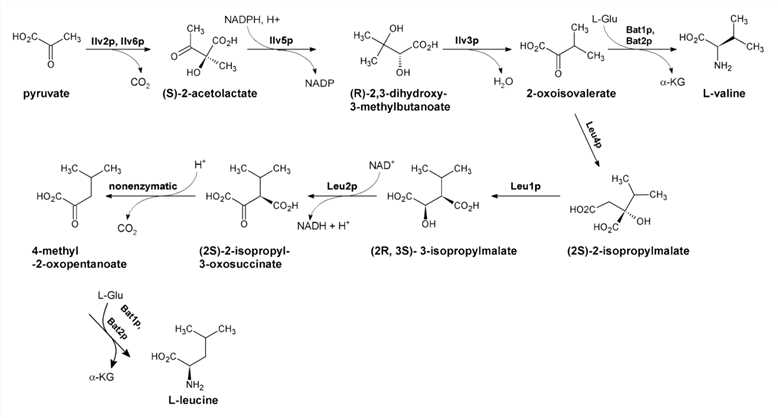Invasive fungal infections are now considered to be a severe threat to human around the world. New data of mortality rate caused by invasive fungal infection indicates antifungal drug discovery should be of great concern. As an international leading CRO in the industry of antifungal drug discovery, Creative Biolabs now provides a wide range of services for target identification and validation services. Here, we focused on the acetohydroxyacid synthase as a potential target.
Acetohydroxyacid Synthase
Acetohydroxyacid synthase (AHAS), also known as acetolactate synthase, is an enzyme with catalytic activity found in plants and micro-organisms. This enzyme is a transketolase or a transaldolase, belonging to the transferase family that transfer aldehyde or ketone residues. It is involved in the biosynthesis of various amino acids. Specifically, AHAS is responsible for catalyzing the conversion of two molecules of pyruvate to 2-acetolactate or to convert one molecule of pyruvate and a molecule of 2-ketobutyrate into 2-aceto-2- hydroxybutyrate.
Acetohydroxyacid Synthase as a Target for Antifungal Drug Discovery
AHAS catalyzes the first reaction in the pathway for synthesis of the branched-chain amino acids (BCAA). This pathway is found in microorganisms and in plants but not in animals, making it an attractive target for antifungal drug discovery. Evidence accumulated so far suggests that the enzymes catalyzing methionine, threonine, and branched- chain amino acid biosynthesis, especially homoserine dehydrogenase, homoserine transacetylase, homoserine kinase, methionine synthase, threonine synthase, and AHAS as the most promising antifungal target candidates.
 Fig.1 Biosynthesis of branched amino acids in fungi. (Jastrzębowska, 2015)
Fig.1 Biosynthesis of branched amino acids in fungi. (Jastrzębowska, 2015)
The sulfonylureas have been regarded as an excellent starting point for the development of new antifungal drugs, due to their high affinity to AHAS and the low cytotoxicity. Many compounds of this type, such as sulfonylurea derivatives, chlorimuron ethyl (CE) and ethoxysulfuron (ES), were tested for their ability to inhibit the growth of C. albicans in cell culture media and via disk diffusion method. Furthermore, significant antifungal activity against C. albicans shows some other promising inhibitors of AHAS, known as triazolo-pyrimidine-sulfonamides.
Why Choose Us?
Creative Biolabs offers the best guarantee in the industry of antifungal drug discovery and has successfully developed a series of antifungal target identification services for our worldwide clients. To meet the challenging requirements, we have built a team of experienced scientists with facilities and processes designed specifically to provide the best strategy and protocols for Fungal Nucleic Acid and Protein Biosynthesis Targets, including:
In addition to the identification of potential targets for antifungal drug discovery, you might be also interested in other services for Potential Targets for Antifungal Drug Discovery listed below:
If you have any special needs in discovering potential targets for antifungal drugs or be interested in learning more about our antifungal drug discovery services, please feel free to contact us for more details.
Reference
-
Jastrzębowska, K.; Gabriel, I. Inhibitors of amino acids biosynthesis as antifungal agents. Amino acids. 2015, 47(2), pp.227-249.
For Research Use Only.


 Fig.1 Biosynthesis of branched amino acids in fungi. (Jastrzębowska, 2015)
Fig.1 Biosynthesis of branched amino acids in fungi. (Jastrzębowska, 2015)


